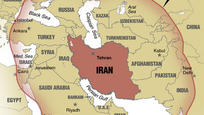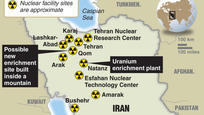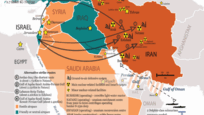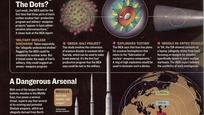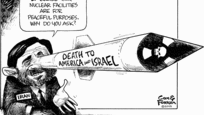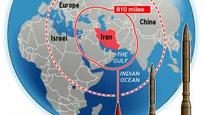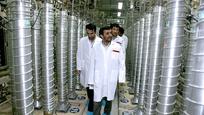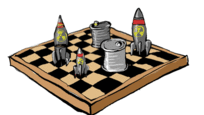A Nuclear Iran: Fears and Prospects
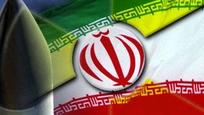
This article is an attempt to clear up some basic questions around the Iranian nuclear crisis, which is one of the most polarizing issues in one of the world's most volatile regions. The US and its allies believe Iran is planning to build nuclear weapons, although Iran's leadership says that its nuclear program is peaceful. The west were working on sanctions against Iran, the US was asking Israel to hold off on any military strike against Iran’s nuclear facilities. Some think there are no good options for dealing with this challenge. This article was published in the AARMS international journal. Download - 158 KB (PDF)
A Nuclear Iran: Fears and Prospects
Since 2006, the United Nations Security Council has repeatedly called on Iran to halt its uranium enrichment[1] since Washington and its allies say that Tehran is seeking the ability to make nuclear weapons, a charge it strongly denies. The common knowledge is that a nuclear-armed Iran would usher in a dangerous new era of instability in the Gulf and Middle East, furthermore it would spark a nuclear arms race in the region, leading to the collapse of the global nuclear non-proliferation regime. Recently Tehran rejected an offer to have its uranium enriched by other nations for use in a medical research reactor – a proposal that would have provided some breathing space for diplomacy. Then in early March, the regime accelerated its efforts to enrich uranium to a higher level, taking it one step closer to the bomb (BROAD, 2010).[2] Many experts believe Iran could develop a nuclear weapon by the middle of next year, and a nuclear-armed missile in five years or less, which makes the situation more complicated (BERMAN, 2010).
The United States has been leading a push for the United Nations Security Council to impose tough sanctions on Iran, though that effort appeared to be stalled by Russia and China for a while.[3] Since Iran has been refusing to comply with the demands for cooperation and transparency, leaving less and less room for diplomatic maneuvering, Russia seems ready to consider supporting sanctions tailored to prevent the spread of nuclear weapons, and China has finally agreed to engage substantively on the issue (BARRY, 2010).
What Iran wants?
It is not difficult to understand Iran’s motives for seeking a nuclear-weapons capability. Although Iraqi missile and chemical-weapons attacks were certainly a motivating factor behind the resumption of the enrichment program in the 1980s, Iran today seeks a nuclear-weapons capability not so much for deterrence as for the prestige that possession of such advanced technologies bestows. Iran’s regional leadership aspirations are another driver: possession of a nuclear-weapons capability is seen as conferring the major-power status that Iran seeks. The deterrence factor too cannot be denied. Iran’s motivation is understandable. However Iranian officials insist that their country does not seek nuclear weapons. They may be making a distinction between developing a weapons capability and taking the final step of building weapons considering that possession of nuclear weapons would undermine Iran’s security by making it sure target for US and Israeli attack and worldwide economic boycott, with loss of the protection offered by Russia and China. Viewed from outside Iranian intentions are unclear. In any case, Iran’s leaders do not yet need to make a decision about whether to produce nuclear weapons. They can wait until after the fissile material is produced to decide if and when to develop a weapon. What Iran has certainly decided is to acquire the technical capability to produce fissile material. Its goal is to bring the country tight up to the threshold of a break-out capability while remaining within the legal limits of the Non-Proliferation Treaty (NPT). Meanwhile, if its uranium-enrichment program continues unabated, Iran will be in a better position to produce a bomb quickly if it so decides (FITZPATRICK, 2008).
Iran seems determined to continue its uranium enrichment. Since talks on the issue began in 2003, Iran has never given any serious indication that it would be willing to give up the aim of acquiring such technology, whatever inducements or disincentives the West might put forward. Since Mahmoud Ahmadinejad won a surprise victory over Rafsanjani in the presidential election in 2005, Iranian officials have insisted that suspension is non-negotiable because enrichment is the ‘national will’, which cannot be changed. The question for the international community is whether even a fully compliant, fully transparent Iran could be trusted with enrichment. Given the apparent military purpose of its program, there is reason to fear that Iran might break out of the NPT and use a stockpile of low enriched uranium (LEU) to quickly produce highly enriched uranium (HEU) for weapons purposes. This concern is not diminished by the fact that the IAEA has never found any evidence of diversion (FITZPATRICK, 2008).
Gareth Evans, the president of the International Crisis Group has said that if Iran's neighbors, including Israel, and the wider world could be confident that the line between civilian and military capability that lies at the heart of the NPT hold in Iran’s case, it would not matter whether the country was capable of producing its own nuclear fuel (EVANS, 2007). The issue is how to build that confidence, and whether it can be built at all while Iran continues enrichment activity. The problem is that the line is almost invisible. It will be impossible to judge for certain if and when Iran has crossed the nuclear threshold. The common wisdom in the West is that Iranian possession of nuclear weapons will not be known until after the fact (FITZPATRICK, 2008).
Iran’s ballistic-missile program magnifies the threat. With technological help from North Korea, Iran fields a Shahab-3[4] missile that can reach Israel, Turkey and Saudi Arabia. It is a single-stage, liquid-fueled medium-range ballistic missile with a range of close to 1,300 kilometers (km). In December 2009, Iran test-launched the latest version of its longest-range missile called Sejil-2[5], which is also capable of hitting Israel and parts of Europe. The Sejil's range is longer than that of the Shahab-3, at an estimated 2,000 km. In addition, its solid propellant has a number of advantages over the Shahab's liquid fuel. Solid-fuel rockets accelerate faster – making them perhaps less prone to being shot down in their vulnerable boost phase by defensive systems. Unlike the Shahab series and most other Iranian missiles, the Sejil bears no outward resemblance to foreign missile types. It might thus represent the rise of an indigenous production capability, in tandem with Iran's more traditional development process, which has relied on foreign technical aid (GRIER, 2009).
Iran and the possibility of nuclear terrorism
The United States has faced the threat of nuclear terrorism for many years, but this peril looms larger day by day. In February the directors of C.I.A., F.B.I., and National Intelligence told Senator Dianne Feinstein that an attempted terrorist attack on the United States in the next few years was “a certainty” (GREENWAY, 2010). Nuclear terrorism experts generally agree that nuclear terror acts with the highest consequences are the least likely to occur because they are the most difficult to accomplish. Conversely, those acts with the least damaging consequences are the most likely to take place because they are the easiest to carry out (FERGUSON, 2005). In this respect, the ease with which terrorists could build and detonate radiological dispersal devices – the so called dirty bombs – or use radioactive material for other harmful purposes makes this kind of nuclear terrorist attack especially concerning.
To fabricate a dirty bomb, terrorists must acquire sufficient fissile or radioactive material, through gift, purchase, theft, or diversion. The most direct means for this would be to obtain it directly from a sympathetic government. Such a combination of rogue state and mass-casualty terrorists is a worst-case scenario that has shaped U.S. foreign policy toward such states and fueled public fears of nuclear terrorism. Today , the greatest sources of concern in this regard are Pakistan, North Korea and especially Iran, which has been one of the world’s most active sponsors since the Islamic Revolution in 1979. Iran has backed not only groups in its Persian Gulf neighborhood, but also terrorists and radicals in Lebanon, the Palestinian territories, Bosnia, the Philippines, and elsewhere. Iran has worked with Islamists such as Hamas, the Palestine Islamic Jihad, Kurdish Hezbollah as well as radical secular groups like the PFLP-GC and the Kurdish Workers Party (BYMAN, 2008).
While there is no evidence that states have deliberately transferred radioactive materials to terrorists groups, all state sponsors of terrorism, as designated by the U.S. State Department,[6] possess high-risk radioactive sources. But it is worth noting that a state that provided radioactive material to terrorists would have to be extraordinarily reckless, given the risk that the material could be traced back to the state. Because the United States would most likely retaliate against a state that had provided radioactive materials to terrorists, states will likely be deterred from doing so (FERGUSON, 2005). Iran’s acquisition of nuclear arms and weapons-usable uranium, however, is particularly threatening because of the Iranian government’s links to terrorist organizations. Understandably, for most Americans, a nuclear weapon in the hands of a terrorist-supporting enemy regime is the ultimate nightmare. Although, to date, there is no indication that the Iranian government has shared fissile materials or any kind of WMD with terrorist organizations, and Tehran is likely to continue this restraint and not transfer radioactive materials or nuclear weapons for several reasons (BYMAN, 2008).[7] Nonetheless, the possibility remains that it might do so in the future.[8]
Sanctions, containment and deterrence
Whether additional sanctions are adopted by the Security Council, or, more likely, by concerned states acting outside the UN, it is doubtful that new coercive measures alone would be effective in terms of changing Iranian policy before the enrichment program advances to the point of giving Iran a latent weapons capability. It is worth noting, that Iran has demonstrated the ability to expand its enrichment program despite several years of export controls and intelligence scrutiny, which can be seen as an indication of the limits of such external controls. However sanctions can play an important deterrent role. Denying Iran the policy benefits of its nuclear status by making it to pay a price for defying the Security Council sends an important signal to others who might wish follow the same route. This should be seen as part of a multifaceted strategy for preventing a proliferation cascade in the Middle East. In the event that Iran does acquire a nuclear-weapons capability, containment and deterrence strategies will be critical to keeping Iran from crossing the line to production. Many Israelis claim that the Iranian regime is different, that, like a suicide bomber, it will be undeterrable. The historical record, however, suggests that when its national security is at stake, Iran behaves in a broadly rational manner (FITZPATRICK, 2008).
Containment has been the US policy of choice on Iran since 1979. In its broad sense, the containment strategy today involves isolation and other means of denying Iran the ability to use a nuclear status to achieve the goals it seeks of Gulf hegemony and heightened prestige and status for the Islamic regime at home and abroad. However a containment strategy based on isolation and deterrence has its drawbacks. Constraining investment in Iran’s oil and gas sectors will not be sustainable in the long term, given increasing global demand and competition for energy supplies. Nevertheless, broad containment policies are easily can be found counterproductive, because they could stimulate a regional arms race and a hardline response from Iran, and could result the radicalisation of Iranian domestic policy.
Fallback proposals
A number of proposals have been made for reducing the risk of Iran crossing the proliferation line. It is widely acknowledged that zero enrichment would be best, but many observers believe that this has become an impossible goal. Working on the assumption that Tehran will never accept zero enrichment and that continuing to demand it is a losing game as the country continues to expand its enrichment capabilities with insufficient safeguards, those who promote fallback proposals favour granting legitimacy to enrichment in Iran in exchange for intrusive inspections. The proponents of the fallback proposals argue that sticking to the policy of zero enrichment is more likely to produce something close to the worst outcome – an unconstrained, under-safeguarded enrichment capability (WALSH, 2008).
Lack of confidence in Iran’s intentions is the central problem. As mentioned before, there are compelling reasons to believe that the principal purpose of Iran’s enrichment program is to create a nuclear-weapons capability. If this is the case, then no technical solution will work, because Iran will not accept any condition that would prevent it from attaining this objective (FITZPATRICK, 2008). However, it is sometimes argued that offering a fallback position would at least test Iran’s intentions, and that, in the event that Iran rejected technical solutions, the United States would be better placed to garner international support for coercive action.
How the Iranian nuclear problem evolves will inevitably have repercussions elsewhere. Tehran’s program has already created the potential for a nuclear-proliferation cascade in the surrounding region. Legitimisation of the Iranian program could increase the security motivations of Iran’s neighbours for seeking such a program themselves, and give them a reason to believe that the United States would eventually accept their nuclear plans as well. Other than Iran and Israel, no country in the greater Middle East region is known today to seek fuel-cycle capabilities. As long as Iran remains under increasing pressure to stop its sensitive nuclear activities and is penalised for failing to do so, its neighbours have a disincentive against seeking enrichment or reprocessing capabilities of their own. Any fallback option that legitimised Iran’s enrichment efforts would diminish that disincentive. Fallback options would confer legitimacy on an enrichment program that the Security Council had officially delegitimised. Once conferred, this legitimacy would not be reversible, and even to make the offer would be to acknowledge the right to enrichment. Taking this into consideration, offering a fallback option that legitimises enrichment in Iran is not the best way to reduce the proliferation risk (FITZPATRICK, 2008).
One of the worst case scenarios: bombing Iran
Some experts maintain that the only viable fallback option is military action aimed at disabling Iran’s sensitive nuclear facilities (PODHORETZ, 2008). However, an increasing number of officials and analysts conclude that bombing Iran would both ineffective and counter-productive, because air strikes would set back the enrichment program just for a short period of time (IGNATIUS, 2008). Moreover, bombing Iran’s nuclear facilities would probably do more spur than to delay the country’s acquisition of nuclear weapons. Any gains that might be had from a bombing campaign would hardly be worth the risk of unintended consequences. It would offer an excuse some Iranians might sorely want to throw out the nuclear inspectors and renounce the NPT. That would leave Iran in the position to manufacture fuel or bombs freely without inspectors. In point of fact, an Israeli military strike might be the “best thing” for Iran’s leadership, because it would bring Iranians together against a national enemy. The opposition would be forced to support a government under attack from abroad. The regime would foment and fund violence from Afghanistan to Iraq to the Gulf. The price of oil would skyrocket – which, ironically, would help Tehran pay for all these operations. Not to say that Al Qaeda and it’s proxies would present the military strike as the third American invasion of a Muslim nation in a decade, proof positive that the United States is engaged in a war of civilizations (ZAKARIA, 2010 A).
Israel, which sees Iran as a direct threat, has refused to rule out military force, although officials there say they are counting for now on diplomatic pressure. While the West pushing for new UN sanctions Israel’s preparations for a strike against Iran’s nuclear program are as evident as ever: the introduction of an attack drone capable of flying hundreds of miles, the frequent open talk of a possible attack, the distribution of new gas masks to the public. It’s also not a coincidence that the American chairman of the Joint Chiefs of Staff, the director of the C.I.A., Obama’s national security adviser and vice president Joe Biden have all just been to Israel to pressing it to hold off and help work out a sanctions regime rather than choose an unilateral military action (BRONNER, 2010 A). The American decision to press Israel to hold its fire stems partly from war game exercises in both countries that have raised complex questions about how effective a strike would be, and how Iran would react (STROBEL, 2010).
Many say this is the time to try to put tougher sanctions against Tehran into place, because there is a common interest to make sanctions work. Israeli officials also agree that the Iranian government and economy are weak and that harsh sanctions could pressure it into changing its nuclear policy. But few believe an attack is imminent. Israel is watching with enormous concern, because they do not want to be lured into what could be an Iranian trap: a confrontation in Lebanon or Syria aimed at diverting the world’s attention from Iran. We should bear in mind, that as a top Israeli official put it: for the Americans, Iran is a strategic threat. For the Israelis, it’s an existential one (BRONNER, 2010 B). Though it is also worth noting that some argue that Israel does not seem truly serious about the Iranian threat (ZAKARIA, 2010 B).[9]
Obviously, the most important factor holding the Israelis back is politics, and more specifically, the importance that close relations with Washington has on the domestic political calculations of Israeli leaders. But if the difference between the U.S. and Israel becomes more significant in the coming year, it is possible that Israel will be ready to take the risk and break ranks with Washington. This would be the worst-case scenario with which many Israelis, including Netanyahu, are unlikely to be comfortable. In this case the resulting breach between Israel and the United States would be unprecedented. Washington occupies two countries in or adjacent to the region, maintains military facilities throughout the Persian Gulf, and relies on Arab governments for logistical support. Hence, in the event of an Israeli attack, Washington would surely be accused of colluding with Jerusalem, severely damaging the United States' position in the region while provoking a ferocious Iranian response in Iraq, Afghanistan, Gaza, and southern Lebanon (COOK, 2009).
New sanctions and the Brazil-Turkey initiative
On June 9, as a product of months of negotiations between the U.S., U.K. and France on the one hand, and Russia and China on the other, the United Nations Security Council finally passed new economic sanctions against Iran for its nuclear work. The resolution, among other things, calls for new curbs on conventional-weapons sales to Iran and steps up international inspections of cargoes shipped in and out of Iran. The new sanctions are less severe than those initially sought by the U.S., and no one in the Obama White House believes that they will force Tehran to halt its 20-year-long drive for a nuclear capability by themselves, because when it comes to stopping countries from getting the bomb, history suggests they are rarely effective. But this new resolution probably will be enough for the White House to pursue a broader financial war against Iran (LAURIA, 2010).
It is worth noting that the new resolution, the U.N.'s fourth round of sanctions against the country since 2006, passed the 15-nation Security Council with only 12 votes in favor. As expected, council members Brazil and Turkey voted against – while Lebanon abstained –, because in May they tried to revive an earlier fuel-swap deal with an agreement signed in Tehran, which was rejected by the permanent members of the council since “it was not a solution for the core of the Iranian enrichment program.” Moreover, officials from several countries said that the deal was a deftly timed attempt to throw the sanctions effort off track (SANGER, 2010 A). Maria Luiza Ribeiro Viotti, Brazil's U.N. ambassador, said sanctions run counter to the "successful efforts" of Brazil and Turkey to engage Iran in a negotiated solution, while Turkey also expressed concern that the adoption of sanctions would "negatively affect the momentum" of the Brazil-Turkey initiative.[10]
Conclusion
Iran is rapidly acquiring the capability to produce nuclear weapons, and recent developments do not bode well for the prospect of successful negotiations that can end concerns about Iran’s nuclear program. Tehran still has far to go to establish convincingly the peaceful nature of its nuclear efforts, though for now the Iranian regime might be unable to make significant concessions on the issue because it remains politically divided and preoccupied with the long-term stability of its rule. In addition, if Iran believes that the West has a fallback plan, there is little reason for it to make any concessions before such a plan is offered (ALBRIGHT, 2009).
Iran has an intermediate nuclear status. It has the technical capability to make nuclear weapons, but it has not acted on that capability, as far as we know (FITZPATRICK, 2008).[11] How the United States and its allies manage this dangerous period of Iran’s growing nuclear weapons capabilities could determine whether Iran takes the step to build nuclear weapons. It is expected that the Obama administration will expand economic, political, and possibly even military pressure on Iran in an attempt to keep Iran from stepping out of its threshold status and convince it to suspend its enrichment program. This will not be easy, because at the same time, the United States needs to avoid both pushing Iran into a corner from which the Iranian leadership believes building nuclear weapons is worth the risk and giving other states in the region incentives to seek nuclear weapons.
Many say Iran constitutes a threat not only to Israel but to the region, to the United States and to the world at large, and therefore should be addressed without delay by the international community, first and foremost through effective sanctions. But in fact it seems the U.S. and Israel still are not certain whether Iran is seeking a nuclear bomb, or just the ability to build one, or even merely the appearance of the ability. Now the guessing game touches on three of the most delicate subjects in the dispute: Whether Israel will strike the facilities and risk igniting a broader Middle East war; whether there is still time to stop the Iranian program through sanctions and diplomacy; and who is really in control of Iran and its nuclear program (SANGER, 2010 B).
We shall not forget that even a "successful" airstrike on Iran's nuclear facilities — setting the program back by just a few years — could come at a tremendous, unpredictable cost. Therefore air strike is an option that has to be looked at very carefully, because the results could be disastrous. Given the risk of unintended consequences in case of a preemptive military action, it is well worth asking how the two worst-case outcomes of an Iran with the bomb and a bombed Iran can both be avoided. Unfortunately, time would appear to be on Iran’s side as it advances its weapon capabilities, considering that no country that has proceeded as far as Iran in nuclear-weapons development has failed to go on to production.[12]
An Iran with nuclear weapons would be dangerous and destabilizing, though it is worth noting that not everyone is convinced that it would automatically force Saudi Arabia, Egypt, and Turkey to go nuclear as well. Probably the protections afforded by American missiles could prevent nuclearization in these countries. Some even argue that the world can live with a nuclear Iran, since it is living with a nuclear North Korea, and it lived with a nuclear Soviet Union and communist China (ZAKARIA, 2010 A). We should also bear in mind that Al Qaeda has expressed interest in acquiring radiological weapons, and while the world focuses on Iran as the greatest potential source of nuclear proliferation, the clearest danger may be forming somewhere else, maybe in Pakistan. And unlike Iran, Al Qaeda would have no reason to develop a bomb other than to use it.
A dual policy of engagement and sanctions, with containment strategies targeted at limiting Iranian access to sensitive technologies and materials, is still the best way to test possibilities for Iranian cooperation while maintaining vigilance and controls to limit the nuclear-proliferation threat. If engagement fails, the sanctions strategy maintains a basis for long-term containment, that can be made working by the Iranian regime’s instinct for self-preservation (CIRINCIONE, 2007).
- - -
[1] Uranium enrichment is the process of increasing the concentration of radioactive U-235 isotopes from the average 0.7% found in uranium in nature either to 3.5-5% to make fuel for reactors or to above 90% for nuclear weapons.
[2] On February 7, 2010, Iran announced it would begin enriching its stockpiled uranium to 20 percent. In this regard we should bear in mind that the enrichment process is “nonlinear”, it accelerates as it moves ahead. Uranium ore has about 140 atoms of the heavy isotope for every light one, and separating the two takes a lot of spinning. By the time the enrichment process has reached 4 percent, it has successfully removed some 115 of the heavy atoms. To get from there to 20 percent the spinning centrifuges need remove only 20 more of the heavy atoms. And from there it is even easier to jump to 90 percent, bomb grade, by removing four or so additional heavy atoms. That is what worries many countries.
[3] Russia and China seek to maintain friendly relations with Iran, primarily motivated in Russia’s case by geostrategic considerations and in China’s by its need for Iranian oil and gas. Yet both states worry about the prospect of a nuclear-armed Iran, and so, however reluctantly, they joined the sanctions strategy.
[4] “Shahab” means “meteor” or “shooting star, ” in Farsi. A series of Iranian missile variants carry the Shahab designation.
[5] “Sejil,” or “Sajjil,” means “baked clay,” in Farsi.
[6] Currently there are four countries on the list of “State Sponsors of Terrorism”: Cuba, Iran, Sudan and Syria. < http://www.state.gov/s/ct/c14151.htm > accessed on July 14, 2010.
[7] As Daniel Byman, the director of Georgetown University's Center for Peace and Security Studies and an expert on counterterrorism and Middle East security writes in his article “Iran, Terrorism, and Weapons of Mass Destruction” that providing terrorists with such unconventional weapons offers Iran few tactical advantages, moreover Iran has become more cautious in its backing of terrorists in recent years, and it is highly aware that any major escalation in its support for terrorism would incur U.S. wrath and international condemnation.
[8] Indeed, in an unusual twist on this theme, in early March 2004, Iran threatened to launch terrorists against Libya because the latter was divulging details of Iran’s secret attempts to develop nuclear arms.
[9] Fareed Zakaria, the editor of Newsweek International thinks that Israel does not seem truly serious about what it claims is its existential threat from Iran, because while the Israeli government talks a great deal about the issue, its actions suggest that this is actually not that much of a priority. If it were one, Israel would do everything it could to deepen its ties with its most important ally, the United States. Instead the Israeli government has ruptured relations with the Obama-administration, and makes little effort on the peace process.
[10] The deal called for Iran to ship 2,640 pounds of low-enriched uranium to Turkey, where it would be stored for one year. In exchange, Iran would have the right to receive about 265 pounds of uranium enriched to 20 percent by other countries for use in a reactor that makes isotopes for treating Iranian cancer patients. Nonetheless, Iran insisted that it would continue its new effort to enrich fuel at a higher level, taking it closer to bomb-grade material.
[11] Possessing an enrichment capability is not the same as having the Bomb. If enrichment alone conferred weapons status, Japan, Germany, the Netherlands and Brazil would be considered nuclear-weapons capable.
[12] Bruni Tertrais made this observation at the IISS Global Strategic Review conference, September 12-14, 2008. Other non-nuclear-weapons states that have developed fissile-material technologies, for example Japan and Brazil, have not engaged in the kind of weapons-development work that Iran is assessed to have undertaken.
References
BROAD, William J., “For Iran, Enriching Uranium Only Gets Easier,” New York Times, March 9, 2010, p. D1. Available < http://www.nytimes.com/2010/03/09/science/09enrich.html > accessed on July 7, 2010.
BERMAN, Howard L., “Iran's Nuclear Clock,” International Herald Tribune, March 19, 2010. Available < http://www.nytimes.com/2010/03/20/opinion/20iht-edberman.html > accessed on July 7, 2010.
BARRY, Ellen and Andrew Kramer, “China and Russia Pressed Iran to Accept U.N. Deal,” New York Times, March 24, 2010. Available < http://www.nytimes.com/2010/03/25/world/middleeast/25iran.html > accessed on July 8, 2010.
FITZPATRICK, Mark, The Iranian nuclear crisis: avoiding worst-case outcomes (London: The International Institute for Strategic Studies, 2008).
EVANS, Gareth, “The Right Nuclear Red Line,” Washington Post, December 5, 2007. Available < http://www.washingtonpost.com/wp-dyn/content/article/2007/12/04/AR200712... > accessed on July 10, 2010.
GRIER, Peter, “Missiles in Iran that still worry Obama and the West,” The Christian Science Monitor, September 19, 2009. Available < http://www.csmonitor.com/USA/Military/2009/0919/p02s01-usmi.html > accessed on July 7, 2010.
GREENWAY, H. D. S., “Al Qaeda's Quest for the Bomb,” International Herald Tribune, February 19, 2010. Available < http://www.nytimes.com/2010/02/20/opinion/20iht-edgreenway.html > accessed on July 10, 2010.
FERGUSON, Charles D., William C. Potter with Amy Sands, Leonard S. Spector, and Fred L. Wehling, The four faces of nuclear terrorism (New York : Routledge, 2005).
BYMAN, Daniel, “Iran, Terrorism, and Weapons of Mass Destruction,” Studies in conflict and terrorism, Volume 31. Number 3. March 2008. p. 169-181. Available < http://www.brookings.edu/~/media/Files/rc/articles/2008/03_iran_byman/03... > accessed on July 10, 2010.
WALSH, Jim, Addressing Iran’s Nuclear Ambitions (Washington, D.C., April 24, 2008).
PODHORETZ, Norman, “Stopping Iran: Why the Case for Military Action Still Stands,” Commentary, February 2008. Available < http://www.commentarymagazine.com/viewarticle.cfm/stopping-iran-br--why-... > accessed on July11, 2010.
IGNATIUS, David, in “Bomb Bomb Iran? Not Likely,” Washington Post, August 3, 2008. Available < http://www.washingtonpost.com/wp-dyn/content/article/2008/08/01/AR200808... > accessed on July 11, 2010.
ZAKARIA, Fareed, “Don’t Scramble the Jets,” Newsweek, Mar 1, 2010. Available < http://www.newsweek.com/id/233854 > accessed on July 11, 2010.
BRONNER, Ethan, “Biden Visits Mideast to Push Peace Talks,” New York Times, March 8, 2010. Available < http://www.nytimes.com/2010/03/09/world/middleeast/09biden.html?fta=y > accessed on July 11, 2010.
STROBEL, Warren P., “War game shows how attacking Iran could backfire,” McClatchy Newspapers, February 21, 2010. Available < http://www.mcclatchydc.com/2010/02/21/87061/war-game-shows-how-attacking... > accessed on July 10, 2010.
BRONNER, Ethan, “Hoping Sanctions Work but Readying Gas Masks,” New York Times, March 5, 2010, p. A12. Available < http://www.nytimes.com/2010/03/05/world/middleeast/05mideast.html > accessed on July 10, 2010.
ZAKARIA, Fareed, “Crisis in U.S.-Israeli Relations,” GPS transcript, March 21, 2010. Available < http://transcripts.cnn.com/TRANSCRIPTS/1003/21/fzgps.01.html > accessed on July 11, 2010.
COOK, Steven A., “Why Israel Won't Attack Iran,” Foreign Policy, June 9, 2009. Available < http://www.foreignpolicy.com/articles/2009/06/09/why_israel_wont_attack_... > accessed on July 10, 2010.
LAURIA, Joe – Solomon, Jay, “U.N. Slaps Iran With New Curbs,” The Wall Street Journal, June 10, 2010. Available < http://online.wsj.com/article/SB1000142405274870457530457529645065611153... > accessed on July 13, 2010.
SANGER, David E. – Slackman, Michael, “U.S. Is Skeptical on Iranian Deal for Nuclear Fuel,” The New York Times, May 17, 2010, page A1 of the New York edition. Available < http://www.nytimes.com/2010/05/18/world/middleeast/18iran.html > accessed on July 13, 2010.
ALBRIGHT, David and Jacqueline Shire, “Iran's growing weapons capability and its impact on negotiations,” Arms control today, Volume 39. Number 10. December 2009. p. 6-14. Available < http://www.armscontrol.org/act/2009_12/AlbrightShire > accessed on July 10, 2010.
SANGER, David E., “Another Puzzle After Iran Moves Nuclear Fuel,” New York Times, February 26, 2010. Available < http://www.nytimes.com/2010/02/27/world/middleeast/27iran.html?hpw > accessed on July 11, 2010.
CIRINCIONE, Joseph, Andrew J. Grotto, Contain and Engage: A New Strategy for Resolving the Nuclear Crisis with Iran, Center for American Progress, February 28, 2007. Available < http://www.americanprogress.org/issues/2007/02/pdf/iran_report.pdf > downloaded on July 10, 2010.
